Analysis of a Predator-Prey Model with Switching and Stage-Structure for Predator
Abstract
This paper studies the behavior of a predator-prey model with switching and stage-structure for predator. Bounded positive solution, equilibria, and stabilities are determined for the system of delay differential equation. By choosing the delay as a bifurcation parameter, it is shown that the positive equilibrium can be destabilized through a Hopf bifurcation. Some numerical simulations are also given to illustrate our results.
1. Introduction
The predator-prey system is important in dynamical population models and has been discussed by many authors [1–15].
In the related studies, a switching predator-prey model which has the switching property of predator was introduced by [7]. It was assumed that the predators catch prey in an abundant habitat. After a decrease in prey species population, the predator moves to another abundant habitat. In [8], the authors investigated a switching model of a two-prey one-predator system and they have shown that the system undergoes a Hopf bifurcation. They used the carrying capacity of prey as the bifurcations parameter. More examples on switching models can be found in [9–11]. Saito and Takeuchi [12] proposed a stage-structure model of a species’ growth consisting of immature and mature individuals. It is assumed that the predators are divided into two-stage groups: juveniles and adults. Only the adult predators are able to catch prey species. As for the juvenile predators, they live with the adult predators. It is assumed that juveniles survive on prey already caught by adults. They live on a different resource which is available in the abundant habitat from the adult predators. Consequently, stage-structure model is more realistic than the model without stage-structure. In [14], it was further assumed that the time from juveniles to adults is itself state dependent. Qu and Wei [15] studied the asymptotic behavior of a predator-prey model with stage-structure. They found that an orbitally asymptotically stable periodic orbit exists in that model.
The purpose of the present paper is to study nonlinear delayed differential equations each of which describes a switching and stage structured predator-prey model. The present paper is organized as follows. In the next section, the main mathematical model is formulated and the positivity and boundedness of solutions are presented. In Section 3, we discuss the local stability of equilibria by analyzing the corresponding characteristic equations and we prove the existence of Hopf bifurcations for the model. Finally, numerical results and a brief discussion are provided.
2. Model
- (1)
It is assumed that two-prey species, denoted by x1 and x2, respectively, can be modelled by a logistic equation when the predator is absent. The parameter r is the prey intrinsic growth rate and k is its carrying capacity.
- (2)
The prey lives in two different habitats and each prey is able to migrate among two different habitats. The parameter p is the probability of successful transition from each habitat and q is inverse barrier strength in going out of the first habitat and the second habitat.
- (3)
The functions βx1/(x1 + x2) and βx2/(x1 + x2) have a characteristic property of a switching mechanism, where β is capturing rate.
- (4)
The parameter δ is the rate of conversion of prey to predator and μ is the death rate of predator.
- (5)
The predators are derived into two-stage groups: juveniles and adults, which are divided by age τ, and they are denoted by yj(t) and y(t), respectively. It is assumed that juveniles take τ units of time to mature and e−γτ is the surviving rate of juveniles to adults. Notice, we assume that the juveniles suffer a mortality rate of γ.
Theorem 1. Every solution of system (1) with initial condition (2) is bounded for all t ≥ 0 and all of these solutions are ultimately bounded.
Proof. Let V(t) = γ(δx1 + δx2 + y + yj). By calculating the derivative of V(t) with respect to t along the positive solution of the system of system (1), we have
Hence, there exists a positive constant C, such that
3. Local Stability and Existence of Hopf Bifurcation
The main goal in this section is to investigate the stability of a positive equilibrium and the existence of a Hopf bifurcation.
- (i)
boundary equilibrium , which is corresponding to extinction of the predator, where is a real positive root of the cubic equation
(11) - (ii)
positive equilibrium , which is corresponding to coexistence of prey and predator and
(12) -
Here is a real positive root of the cubic equation
(13) -
or
(14) -
Obviously, is the one real positive root of (13). The other two values of will be real and positive if
(15)
The next lemma gives conditions for the stability of equilibrium .
Theorem 2. The equilibrium is
- (i)
unstable if ;
- (ii)
locally asymptotically stable if
Proof. We consider the characteristic equation of (16) at the equilibrium E1. It follows that
If , then , and f1(+∞) = ∞. Therefore, f1(λ) has at least one positive root and the equilibrium E1 is unstable.
On the other hand, let ; that is,
Theorem 3. Suppose conditions in (29) hold and e1, e2 > 0, e3 ≥ 0. Then the equilibrium E2 is locally asymptotically stable.
Proof. For h(v) defined in (28), we have
Theorem 4. Suppose that conditions in (29) hold and that
- (i)
either e3 < 0,
- (ii)
or e3 ≥ 0, e2 < 0, and ,
Proof. If e3 < 0, then it follows from (28) that h(0) < 0 and limv→∞h(v) = ∞. Thus, (27) has at least one positive root. If e2 < 0, then is one positive root of dh(v)/dv = 0. Since h(0) = e3 ≥ 0, it follows that h(v) = 0 has at least one positive root. As a consequence, (27) has a positive root ω0. This implies that the characteristic equation (23) has a pair of purely imaginary roots.
Let u(τ) = η(τ) + iω(τ) be the eigenvalue of (23) such that η(τ0) = 0 and ω(τ0) = ω0. If there exists ω0 > 0, such that G(iω) = 0. Then by the first equation of (26), we have
4. Numerical Simulations and Discussion
In this section, we present some numerical simulation of system (9) at different parameters to illustrate our analytic results.
Example 5. Let g = 1.8 b = 0.6 α = 2 d = 3 and we consider the following system:
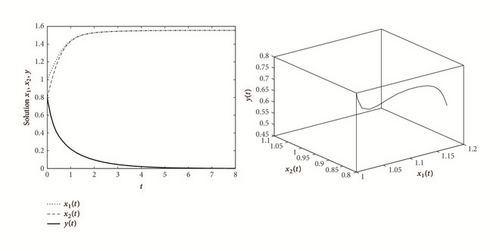
Example 6. As an example, consider the following system:
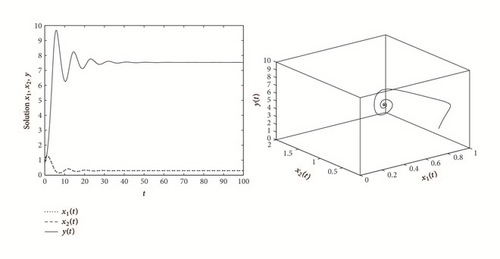
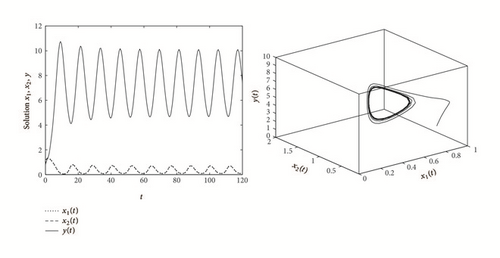
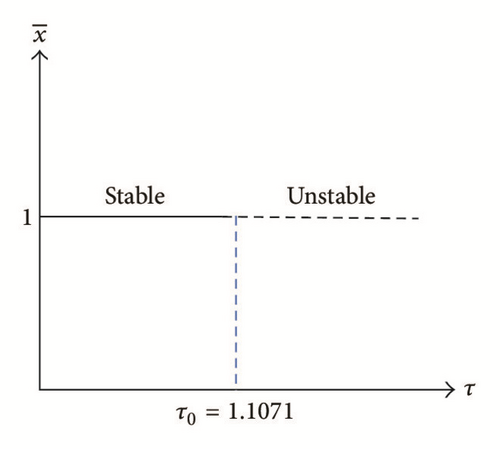
Example 7. As an example, consider the following system:
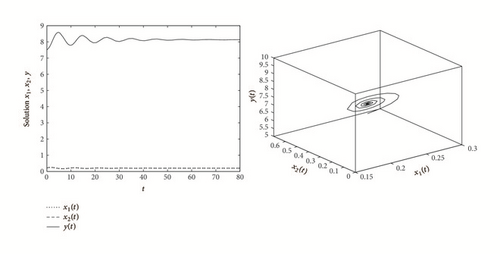

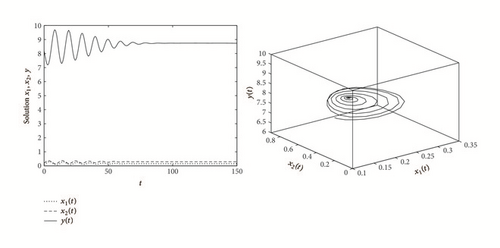
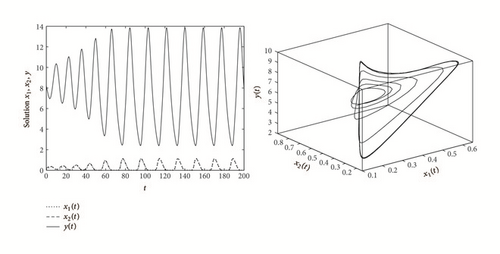
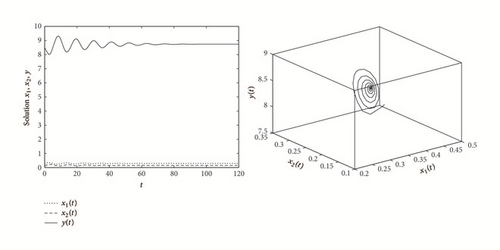
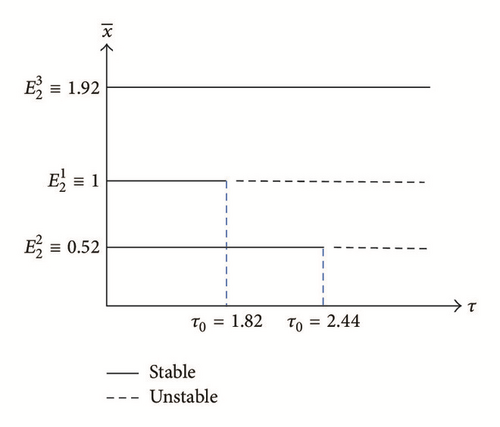
5. Concluding Remarks
In this paper, we find that system (7) has complex dynamics behavior. By Theorem 2, our results show that the predator and prey coexist permanently if ; that is, the adult predators’ reproductive rate at the peak of prey abundance is larger than its death rate. On the other hand, the predator faces extinction, if , which implies that the predator’s possible highest reproductive rate is less than its death rate. We also find the stability switches of the positive equilibrium E2 due to the increase of τ. Our results show that when there is no time delay or the time delay is very small, the positive equilibrium E2 is locally asymptotically stable. As the time delay increases to the critical value, it can cause a stable equilibrium to become unstable and Hope bifurcation can occur.
Conflicts of Interest
The author declares that there are no conflicts of interest regarding the publication of this article.
Acknowledgments
This research was supported by Chiang Mai University, Thailand.




